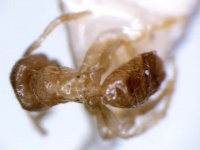Acropyga yushi
| Acropyga yushi | |
|---|---|

| |
| Scientific classification | |
| Kingdom: | Animalia |
| Phylum: | Arthropoda |
| Class: | Insecta |
| Order: | Hymenoptera |
| Family: | Formicidae |
| Subfamily: | Formicinae |
| Tribe: | Plagiolepidini |
| Genus: | Acropyga |
| Species: | A. yushi |
| Binomial name | |
| Acropyga yushi Terayama, 2009 | |
Little is known about this Taiwanese Acropyga species.
Identification
Terayama (2009) - Resembling Acropyga yaeyamensis but easily separated from the latter by the 11-segmented antenna, large eye consisting of about 10 facets, moderately convex promesonotal dorsum, and straight dorsal margin and concave posterior margin of propodeum.
Distribution
Distribution based on Regional Taxon Lists
Oriental Region: Taiwan (type locality).
Distribution based on AntMaps
Distribution based on AntWeb specimens
Check data from AntWeb
Countries Occupied
| Number of countries occupied by this species based on AntWiki Regional Taxon Lists. In general, fewer countries occupied indicates a narrower range, while more countries indicates a more widespread species. |

|
Estimated Abundance
| Relative abundance based on number of AntMaps records per species (this species within the purple bar). Fewer records (to the left) indicates a less abundant/encountered species while more records (to the right) indicates more abundant/encountered species. |

|
Biology
|
Castes
Only known from workers, although Teramaya (2009) noted: A possible female of this species was collected in Nanshanxi, Nanfen-Cun, Nantou Pref. (collection date: 21. viii. 1987).
Nomenclature
The following information is derived from Barry Bolton's Online Catalogue of the Ants of the World.
- yushi. Acropyga yushi Terayama, 2009: 205, figs. 317, 318 (w.) TAIWAN.
- Type-material: holotype worker, 1 paratype worker.
- Type-locality: holotype Taiwan: Kaohsiung Pref., Liukuei, 21.viii.1987 (M. Terayama); paratype with same data.
- Type-depository: NIAS.
- Status as species: Ran & Zhou, 2011: 66.
- Distribution: Taiwan.
Unless otherwise noted the text for the remainder of this section is reported from the publication that includes the original description.
Description
Worker
HL 0.70, HW 0.63, SL 0.58, WL 0.75, PL 0.05, PH 0.18, DPW 0.13, TL 2.0.
Holotype worker. Head 1.12 times as long as wide, with concave posterior margin and parallel sides; frons and vertex largely smooth, but very weakly microreticulate. Mandible with 4 acute triangular teeth. Antenna with 11 segments ; scape not reaching posterior margin of head, 3rd to 8th segments each wider than long, 9th and 10th segments each as long as wide; terminal segment 2.3 times as long as wide. Eye consist of about 10 facets; ca. 0.05 rum long. Promesonotum with weakly convex dorsal margin and about 10 erect hairs on the dorsum; metanotum incised dorsally; propodeum with straight dorsal margin and concave posterior margin. Petiole thin and high, dorsum forming acute angle; in frontal view, node with straight dorsal margin and parallel sides.
Color. Head, alitrunk, petiole yellow; gaster brownish.
Type Material
Holotype. Worker, Liukuei, Kaohsiung Pref. , 21. viii. 1987, M. Terayama leg. Paratype. 1 w, same data as the holotype. Type depository. NIAES.
Etymology
The specific epithet is the Chinese noun Yushi which is the name of a Taiwanese god.
References
References based on Global Ant Biodiversity Informatics
- Guénard B., and R. R. Dunn. 2012. A checklist of the ants of China. Zootaxa 3558: 1-77.
- Ran H., and S. Y. Zhou. 2011. Checklist of Chinese Ants: the Formicomorph Subfamilies (Hymenoptera: Formicidae) (I). Journal of Guangxi Normal University: Natural Science Edition. 29(3): 65-73.
- Terayama M. 2009. A synopsis of the family Formicidae of Taiwan (Insecta: Hymenoptera). Research Bulletin of Kanto Gakuen University. Liberal Arts 17:81-266.
- Terayama Mamoru. 2009. A synopsis of the family Formicidae of Taiwan (Insecta, Hymenoptera). The Research Bulletin of Kanto Gakuen University 17: 81-266.
- Terayama, M. 2009. A synopsis of the family Formicidae of Taiwan (Insecta; Hymenoptera). The Research Bulletin of Kanto Gakuen University 17: 81-266.


